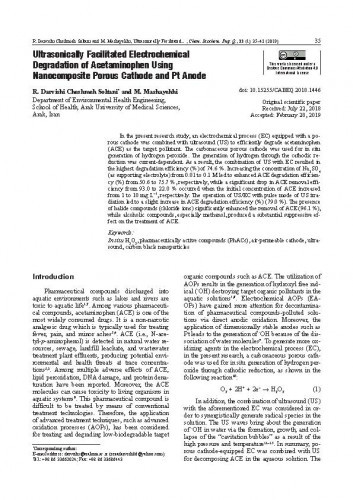In the present research study, an electrochemical process (EC) equipped with a porous cathode was combined with ultrasound (US) to efficiently degrade acetaminophen (ACE) as the target pollutant. The carbonaceous porous cathode was used for in situ generation of hydrogen peroxide. The generation of hydrogen through the cathodic reduction was current-dependent. As a result, the combination of US with EC resulted in the highest degradation efficiency (%) of 74.6 %. Increasing the concentration of Na2SO4 (as supporting electrolyte) from 0.01 to 0.1 M led to enhanced ACE degradation efficiency (%) from 50.6 to 75.7 %, respectively, while a significant drop in ACE removal efficiency from 93.0 to 22.0 % occurred when the initial concentration of ACE increased from 1 to 10 mg L–1, respectively. The operation of US/EC with pulse mode of US irradiation led to a slight increase in ACE degradation efficiency (%) (79.0 %). The presence of halide compounds (chloride ions) significantly enhanced the removal of ACE (96.1 %), while alcoholic compounds, especially methanol, produced a substantial suppressive effect on the treatment of ACE.
Sažetak
Dio od

 Chemical & biochemical engineering quarterly : the international publication of "Kemija u industriji" : the official journal of Croatian Society of Chemical Engineers, Faculty of Chemical Engineering and Technology University of Zagreb, Slovenian Chemical Society, and Austrian Association of Bioprocess Technology : 33,1(2019) / Co-Editors-in Chief: M. Rogošić, B. Zelić.
Chemical & biochemical engineering quarterly : the international publication of "Kemija u industriji" : the official journal of Croatian Society of Chemical Engineers, Faculty of Chemical Engineering and Technology University of Zagreb, Slovenian Chemical Society, and Austrian Association of Bioprocess Technology : 33,1(2019) / Co-Editors-in Chief: M. Rogošić, B. Zelić.